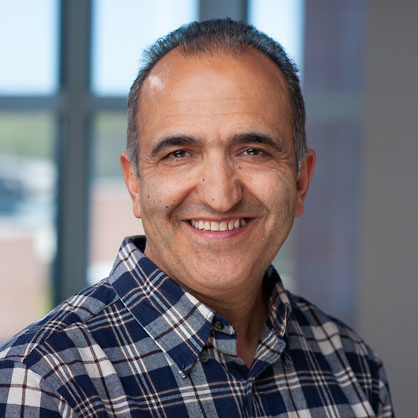Ali Senejani, Ph.D.

Coordinator, M.S. Cellular & Molecular Biology
Biology and Environmental Science Department
College of Arts and Sciences
Education
Post-doctoral training, Yale University School of Medicine
Ph.D., Genetics, University of Connecticut
M.S., Biotechnology, Mannheim University of Applied Science, Germany
Research Interests
My broad research objective is to study DNA damage and repair. I would like to contribute to our understanding of how different environmental factors, chemotherapies, and radiations can damage DNA. Also, to study how the genetic variants in DNA repair pathway genes in the normal population and in patients can influence individual susceptibility and development of diseases such as cancer and autoimmunity.
Environmental and genetic factors are both important to promote genomic instability that lead to a series of mutations, some of which trigger initiation and/or progression of many diseases. The maintenance of genome integrity is dependent on numerous mechanisms, which notably allow fidelity of DNA replication and repair of damaged DNA. Those processes require a large number of proteins including DNA repair proteins to proceed. There are several hundreds of DNA repair protein variants in the germline of the human population and even more in aged populations and people with diseases; therefore it is important to uncover the correlation between altered DNA repair genes and human diseases. I am very interested to contribute to the in-depth understanding of the cellular, biochemical, and molecular genetic aspects of DNA repair, mutagenesis, cell cycle regulation, apoptosis and other biological responses in cells exposed to genomic insult.
Peer Reviewed Publications
- Abolfath R., Khalili M., Senejani A.G., Kodery B., Ivker R. “The Dependence of Compensation Dose on Systematic and Random Interruption Treatment Time in Radiation Therapy” Onco (MDPI) 2022, 2(3), 264-281
- Zhao Sh., Habib S.L., Senejani A.G., Sebastian M., Kidane D.“Role of Base Excision Repair in Innate Immune Cells and Its Relevance for Cancer Therapy” Biomedicine 2022, 10(3), 557
- Senejani A.G., Maghsoudlou J., El-Zohiry D., Gaur G., Wawrzeniak K., Caravaglia C., Khatri V.A., MacDonald A., Sapi E. “Borrelia burgdorferi co-localizing with amyloid markers in Alzheimer’s disease brain tissues” J Alzheimers Dis. 2022;85(2):889-903. doi: 10.3233/JAD-215398.
- Torres J.P., Senejani A.G., Gaur G., Oldakowski M., Murali K., Sapi E. “Ex vivo murine skin model for B. burgdorferi biofilm” Antibiotics (Basel) 2020 Aug 19;9(9):E528. doi: 10.3390/antibiotics9090528.
- Wawrzeniak K., Gaur G., Sapi E., Senejani A.G. “Effect of Borrelia burgdorferi outer membrane vesicles on host oxidative stress” Antibiotics (Basel) 2020; 9(5); 275 (15 pages). doi: 10.3390/antibiotics9050275.
- Farzad N., Cui C., Senejani A., Sinha S. “Ultra-sensitive point of care biosensor for detecting pathogeneses” International Journal of High Speed Electronics and System, 2019 Vol. 28, Nos. 3 & 4, 1940014
- Senejani A.G., Magrino J.M., Marston A., Gregoire M., Dinh K.D., “Menadione induces DNA damage and superoxide radical level In HEK293 cells” SciencePG Cell Biology, 2019; 7(2); 14-22
- Maung M.T., Opper S., Taisma K., Kirkor E.S., Senejani A.G., Sinha S.K. “In-situ and quick detection of RNA virus by nanobiosensor” Biophysical Journal, 2019 Vol. 116, Issue 3, p444a
- Farzad N., Opper S., Taisma K., Kirkor E.S., Senejani A.G., Sinha S.K. “Highly selective bionanosensor for quick detection of bacterial pathogens in food” Biophysical Journal, 2019 Vol. 116, Issue 3, p316a
- Alnajjar K., Ray S., Schechter A., Senejani A.G., Robison S., Criswell L., Dragon L., Sweasy J.B. “Base excision repair in the etiology of lupus and cancer” Book Chapter: The Base Excision Repair Pathway, 2017 pp. 449-499; ISBN: 978-981-4719-72-8
- Lokanga R., Senejani A.G., Sweasy J.B., Usdin K. “Heterozygosity for a hypomorphic Pol β mutation reduces the expansion frequency in a mouse model of the repeat expansion disease Fragile X syndrome” PLOS Genetics 2015; 17;11(4) :e1005181)
- Park H.J., Kim D.H., Choi J.Y., Kim W.J., Kim J.Y., Senejani A.G., Hwang S.S., Kim, L.K., Tobiasova Z., Lee G.R., Craft J., Choi J., Bothwell A.L., Choi J.M. “PPARγ negatively regulates T cell activation to prevent follicular helper T cells and germinal center formation” PLOS One 2014; 12;9(6)
- Senejani A.G., Liu Y., Kidane D., Maher S.E., Zeiss C.J., Park H., Kashgarian M., McNiff J.M., Zelterman D., Bothwell A., Sweasy J.B. “Mutation of a DNA repair enzyme causes Lupus in mice” Cell reports (CELL PRESS) 2014; 16;6(1):1-8. doi: 10.1016/j.celrep.2013.12.017.
- Ray S., Menezes M.R., Senejani A., Sweasy J.B. “Cellular roles of DNA polymerase beta” Yale J Biol Med 2013; 13;86(4):463-469
- Sjolund A.B., Senejani A.G., Sweasy J.B. “MBD4 and TDG: multifaceted DNA glycosylases with ever expanding biological roles” Mutation Research (ELSEVIER) 2013; 743-744:12-25
- Senejani A.G., Dalal S., Liu Y., Nottoli T., McGrath J., Clairmont C.S., Sweasy J.B. “Y265C DNA polymerase beta knock-in mice survive past birth and accumulate base excision repair intermediate substrates” Proc Natl Acad Sci USA 2012; 109(17): 6632-7
- A.G. and Sweasy J.B. “Eukaryotic gene invasion by a bacterial mobile Insertion sequence element IS2 during cloning into a plasmid vector” Genome Integrity 2010; 1(1):2.
- Swithers K.S., Senejani A.G, Fournier G.P., Gogarten J.P. “Conservation of intron and intein insertion sites: implications for life histories of parasitic genetic elements” BMC Evol Biol 2009; 9:303 “BMC Highly accessed article”
- Senejani A.G. and Gogarten J.P. “Structural stability and endonuclease activity of PI-SceI GFP-fusion protein” Int J Biol Sci 2007; 3:205-211
- Gogarten J.P., Senejani A.G., Zhaxybayeva O., Olendzenski L. and Hilario E. “Inteins: Structure, Function, and Evolution” Annul. Review of Microbiology